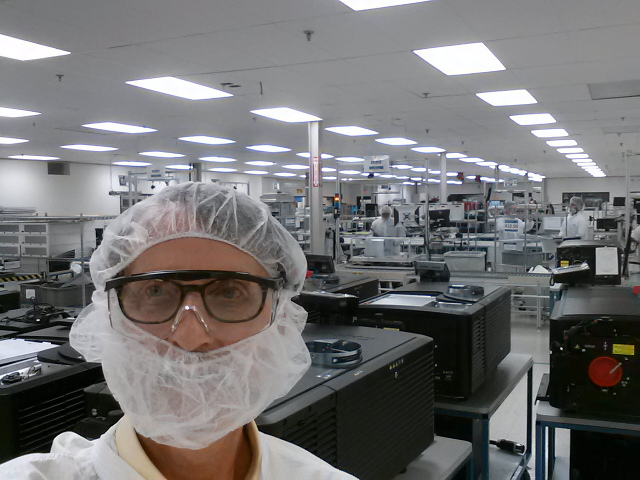Digital Cinema – In a special visit to Christie Digital in Kitchener, Ontario, Insight Media had a chance to see something few have seen yet – a new Christie projector that offers a significant increase in contrast and will soon be suitable for projecting high dynamic content in theatrical venues.
The secret behind the innovation is a dual-engine architecture. That is, they couple two 3-chip DLP engines in series to create the huge boost in contrast. The concept is similar to what Dolby (and previously Brightside Technologies) does with high dynamic range (HDR) LCD. In the LCD, a direct backlight with dozens to hundreds of zones is used to create a non-uniform backlight that changes from frame to frame. Within each zone, the average picture level is calculated (probably a little more sophisticated than that) and a brightness level is set for the backlight. When looking at just the backlight image alone, it is a really low resolution grayscale representation of the content at any time.
Christie apparently uses a similar approach, but with a two-stage, 3-chip DLP architecture, it can create a second modulation step for each pixel in the red, green and blue channels. The first stage sets the mid-point of the desired grayscale so the second stage can apply additional modulation to increase the dynamic range of the display. Details of the design remain a secret, however.
Contrast in such a system is multiplicative. A single stage 3-chip DLP engine typically has an on/off contrast ratio of 2,000:1. With the new two-stage prototype developed by Christie, the on/off contrast can theoretically rise to 4M:1. ANSI contrast is significantly lower, but still appears to be far better than any other projector I have ever seen. Christie engineers tell us that the typical large block size of the black and white ANSI checkerboard pattern negatively impacts the measurement because the luminance of the white squares contaminates the black squares. Instead, if you put four small white segments in the corners of the screen to reduce this effect, the ANSI contrast measurement would give a much better indication of the system’s capability. Maybe it is time to re-evaluate the ANSI contrast measurement in the HDR era.
We were shown several clips to illustrate the capabilities of the display. The first thing you notice is that the ever present “glow” of the so-called black screen disappeared when they engaged the HDR mode. Now, you could not see where the projected image ended and where the screen/wall continued.
The clips were Hollywood movies that were remastered to support the new HDR display. The remastering process is similar to what Dolby has been proposing, but Christie would not comment on whether they worked with Dolby on the project. Normally, movies are color timed to 48 nits (14 Ft-L peak luminance at screen center) for theatrical projection. But the Christie master was done at a 400 nits peak luminance level – eight times higher than a standard theatrical release. That allows the specular highlights in some scenes to be eight times brighter than would normally be possible in standard movie releases.
The black level is also much lower with the new system. Normal theaters spec a black level with the projector on, warmed up and displaying a black frame at 0.03 nits, which works out to about a 1600:1 contrast ratio. Christie did not tell us how black the system is now, but it is a lot darker.
The impact of this was evident on one Hollywood scene that was very dark. The mastering process was able to pull more information out of the dark parts of the scene, but the current gamma (2.6) was clearly not adequate as there were posterization and quantization errors in these dark areas. The current gamma simply does not allocate enough bits to the very subtle dark levels as they could never have been seen previously.
The high peak luminance capability was evident too, but not as striking as some of the Dolby Vision flat panel demos. Sparks in one scene were really punched up and were very bright and sparkly. I also noticed some of the colors changed like the sky (deeper blue) and some architectural lights (almost a neon blue color). It was not clear if this was enabled by the higher dynamic range or was simply a colorist choice.
The prototype projector was big, but any commercial version will be much smaller said the company. In addition, it will be compatible with Christie’s 6P laser projection approach, which uses two synchronized projectors for 3D projection.
HDR is gaining interest in the studios and trial content is being mastered. TVs with HDR will be in the market this year, so theatrical must have a version to compete. Expect to see this in high end movie theaters sometime next year, with broader projection market availability soon after. Christie has now shown their pilot version, but you can bet others are working on similar solutions. Exciting times. – Chris Chinnock

Getting the projector manufacturing tour at Christie’s Kitchener facility

